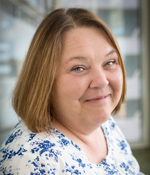
Even if some members of a goal-driven group don’t seem to work well with others — even if the whole group is extremely frustrated — the group can still compromise and find new ways to produce a successful outcome.
This sounds like a political allegory, but it’s actually a novel finding about migrating cells detailed in a new paper by UC Merced Physics Department Chair Professor Ajay Gopinathan and his colleagues, published today (Sept. 12) in Science Advances .
In much the same way groups of starling form coordinated swirling patterns in flight and flocks of ducks and geese migrate south for the winter, certain groups of cells in our bodies mass-migrate in a coordinated fashion toward chemicals that attract them to achieve specific goals. These migrations can be involved in beneficial functions, such as healing wounds, or harmful ones, such as metastasizing cancer.
The researchers studied clusters of malignant cancer cells and discovered that they move in three distinct phases: running, or moving mostly together in one direction; rotating, or moving in a circular motion around the cluster’s center; or randomly, a phase in which cells are uncoordinated and agitated and the cluster doesn’t move much.
The cells will get where they are going, but they frequently and spontaneously switch between all three phases — not a phenomenon typically seen in mass-migrating organisms. The origins of this behavior are unclear and inspired the study.
The research was carried out by an international team including cell biologists Gema Malet-Engra and Giorgio Scita from Italy; computer scientist Weimiao Yu from Singapore; physicist Nir Gov from Israel; and the paper’s lead author, UC Merced graduate student Katherine Copenhagen, who finished her Ph.D. with Gopinathan in the School of Natural Sciences and has moved on to Princeton University for a postdoctoral position.
Together, using computer models originally developed to study flocking birds and schooling fish, they discovered that cells in different areas of the cancerous group behave differently. The ones in the middle sense their neighbors all around and move slower and more randomly. The ones on the group’s margins, having fewer neighbors, tend to move quicker and with a more unified purpose.
“The cells on the outside rim are in the running phase and want to move, while those in the core are in the random phase and just want to stay put,” Gopinathan said. “But the rim and core cells are stuck with each other, which is why the cluster as a whole is frustrated.”
"If we can understand the rules, we can hope to engineer the outcomes, either enhancing or suppressing migration as desired."
That means sometimes the rim wins and the cluster runs, while at other times the core wins and the cluster remains in place. But sometimes, the frustration is relieved through a compromise where the cluster rotates, allowing the rim cells to move faster even while the core cells move slower.
Because the cells are migrating toward higher concentrations of the specific chemicals that attract them, the rotations are potentially beneficial. They allow different cells to take up leading positions in the cluster where the concentrations are highest, Gopinathan explained.
Changing positions allow cells to “share the load” and ensures robust migration. While this sort of load sharing happens in the animal kingdom, for example in penguin huddles and wild geese flocks, it emerges spontaneously in cell clusters just from the underlying physics.
“If we can understand the rules, we can hope to engineer the outcomes, either enhancing or suppressing migration as desired,” said Gopinathan, an affiliate of the Health Sciences Research Institute and a director of the NSF-funded CREST Center for Cellular and Biomolecular Machines (CCBM), where researchers study how biological matter such as proteins or cells assemble to perform specific tasks. Eventually, CCBM researchers want to be able to engineer and develop innovations that could include designer cells and tissues as well as novel diagnostic and therapeutic devices.
The next steps for this research include translating the current understanding of clusters in laboratory settings to the more complex environments inside living bodies and using the model to explore similar phenomena in other types of cellular clusters.
“This just goes to show that a little bit of conflict and frustration is not necessarily a bad thing,” Gopinathan said. “It can lead to interesting and useful outcomes.”

Senior Writer and Public Information Representative
Office: (209) 228-4406
Mobile: (209) 201-6255